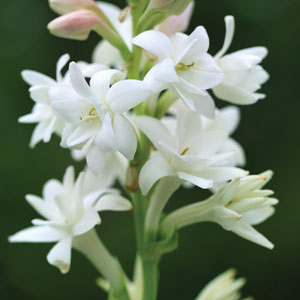Tuberose Growing Guide

What is Tuberose?
Tuberose (Polianthes tuberosa) also known as Polyanthus Lily is a herbaceous perennial bulb. It is part of the Agavaceae family and is native to Mexico. Tuberose is a clump forming bulb that produces bright green strappy shape leaves that are upright and grass in appearance. Smaller leaves form along the stems. In late Summer through Autumn tall flower spikes will appear that carries clusters of sweetly fragrant white star shaped flowers. The flowers bloom from the base and open upwards. In mild climates it can flower pretty well all year round. The tuberose prefers a full sun position in the garden that is sheltered from strong winds.
Benefits of Growing Tuberose
Tuberose is an easy to grow bulb that multiplies readily and are very easy to divide. They produce tall showy flowers that are sweetly fragrant and would work well in a scented garden. They make excellent cut flowers and are highly sort after by florists for adding fragrance to bouquets and cut flower arrangements.
How to Grow Tuberose
Climatic Zones
Cool to tropical
Plant Size
Height: 70cm-1.2m, Width: 10-20cm
When To Plant Tuberose
Plant in late Winter to early Spring
Soil Preparation
Tuberose like a well drained and rich soil. Dig through well broken down organic matter into the soil before planting. The soil must be lime free.
How To Plant Tuberose
Plant in full sun, 15-20cm apart with the tip of bulb just at soil surface.
Tuberose Plant Care
Soil needs to be moist at time of planting but keep fairly dry until green tips emerge. Keep moist during the growing period and continue watering until foliage starts to yellow and die off as bulb goes into dormancy over Winter.
Once growth appears apply complete plant food.
Leave the bulbs in the ground and divide only every 2 to 3 years. Dig up the bulbs around May and June, cut off old leaves and allow to dry. Shake off dirt and trim roots. Small bulbs can be separated and should flower in the following season. The large bulbs which have flowered are discarded as they will not flower again.
Generally trouble free but watch for snails, slugs and thrip.







